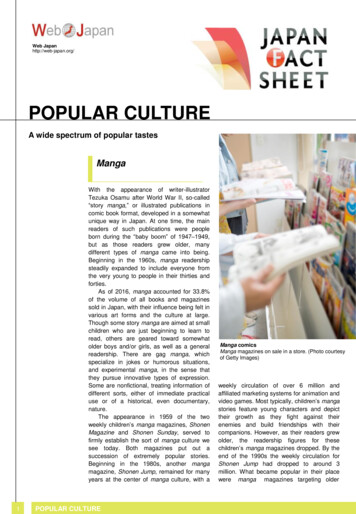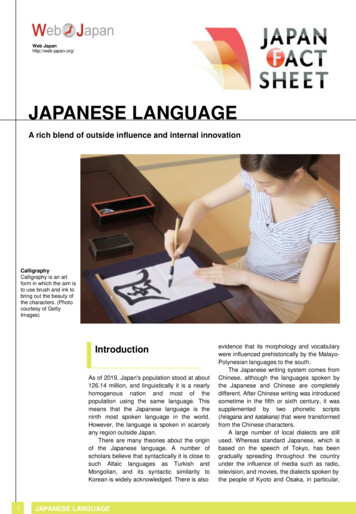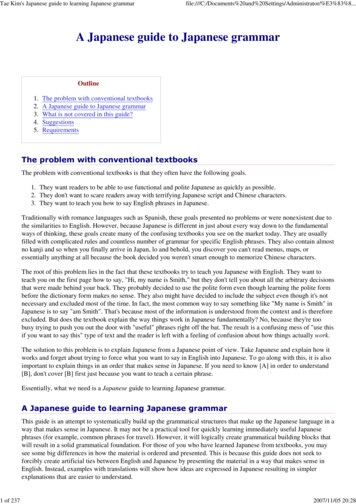
Transcription
Web Japanhttp://web-japan.org/POPULAR CULTUREA wide spectrum of popular tastesMangaWith the appearance of writer-illustratorTezuka Osamu after World War II, so-called“story manga,” or illustrated publications incomic book format, developed in a somewhatunique way in Japan. At one time, the mainreaders of such publications were peopleborn during the “baby boom” of 1947–1949,but as those readers grew older, manydifferent types of manga came into being.Beginning in the 1960s, manga readershipsteadily expanded to include everyone fromthe very young to people in their thirties andforties.As of 2016, manga accounted for 33.8%of the volume of all books and magazinessold in Japan, with their influence being felt invarious art forms and the culture at large.Though some story manga are aimed at smallchildren who are just beginning to learn toread, others are geared toward somewhatolder boys and/or girls, as well as a generalreadership. There are gag manga, whichspecialize in jokes or humorous situations,and experimental manga, in the sense thatthey pursue innovative types of expression.Some are nonfictional, treating information ofdifferent sorts, either of immediate practicaluse or of a historical, even documentary,nature.The appearance in 1959 of the twoweekly children’s manga magazines, ShonenMagazine and Shonen Sunday, served tofirmly establish the sort of manga culture wesee today. Both magazines put out asuccession of extremely popular stories.Beginning in the 1980s, another mangamagazine, Shonen Jump, remained for manyyears at the center of manga culture, with a1POPULAR CULTUREManga comicsManga magazines on sale in a store. (Photo courtesyof Getty Images)weekly circulation of over 6 million andaffiliated marketing systems for animation andvideo games. Most typically, children’s mangastories feature young characters and depicttheir growth as they fight against theirenemies and build friendships with theircompanions. However, as their readers grewolder, the readership figures for thesechildren’s manga magazines dropped. By theend of the 1990s the weekly circulation forShonen Jump had dropped to around 3million. What became popular in their placewere manga magazines targeting older
A scene from an anime(Photo courtesy of AFLO)2readers. Originally aimed at young men intheir 20s and 30s, these manga come with awide range of styles and topics—issuesrelating to life as a student or adult, or socialissues and economic matters—capturing awider demographic of readers. From the early2000s, so-called “moe manga,” or “crushmanga” dealing with love and infatuationbecame a very popular genre. “Moe” is aJapanese slang word that refers to the strongfeelings people get for certain characters. Thecharacters are drawn with rounded lines andexaggerated features; the stories are notbased on combat or fantasy like the children’smanga but generally develop around theeveryday lives of normal female high schoolstudents. Some moe manga have beenanimated, and this, in turn, has widened theaudience.The manga-for-girls genre has alsobecome prominent. Female manga artistsborn in the 1960s, as well as those of the“babyboom”generation,cametodemonstrate their talents in the 1970s and1980s. They gradually widened the range ofartistic expression for manga productions.Delicate psychological depictions are madethrough special types of illustrative techniquesnot usually seen in manga produced primarilyfor boys.Since the early 1990s there has been anotable increase in the export of Japanesemanga to Europe, America, and countries inAsia. In places like Taiwan, Hong Kong, andSouth Korea, which used to be known fortheir pirated editions, large numbers of themost recent popular manga from Japan arepublished in translation through formal licenseagreements with large Japanese publishers.In Europe and America, the popularity ofbroadcasts of Japanese animation ontelevision has greatly increased interest inmanga. Shelves lined with manga featuringthe stories of animation series such asDragon Ball (by Toriyama Akira) and Yu-GiOh! (by Takahashi Kazuki) are now a familiarsight in U.S. bookstores. In 2002, a majorJapanese manga publisher established anoverseas affiliate to market translated editionsof Japanese manga and distribute animatedmanga. The company launched a monthlyPOPULAR CULTUREEnglish-language edition of Shonen Jump in2003. In 2012, the print version is finishedpublishing, and in lieu of it the digital versionis being released on a weekly basis.As of 2017, NARUTO, a manga serial inthe Shonen Jump magazine, in which themain character is a ninja boy, has beenrepublished in book form and distributed inmore than 30 countries. The animated versionis on the air in more than 80 countries.Another major manga series in the ShonenJump magazine is ONE PIECE, an oceanadventure story with a pirate boy as the maincharacter. Having spawned an animatedtelevision series, films, and games, ONEPIECE has been distributed in more than 35countries and regions. The magazine hasproduced another series which has gainedglobal recognition. Kochira Katsushika-kuKameari Koen Mae Hashutsujo is a gagmanga featuring police officer RyotsuKankichi and many unique characters, whichwas serialized between 1976 and 2016. Withthe publication of the 200th volume, the seriesreceived the Guinness World Record for"Most volumes published for a single mangaseries." Japanese manga and animation haveclearly expanded beyond their original groupof hardcore fans to become a significant partof Western pop culture as a whole.Kochira Katsushika-ku Kameari Koen MaeHashutsujo, which ran for four decades, ended withthe 200th volume, gaining many fans along the way.(c) Osamu Akimoto, Atelier Biidama/Shueisha
A scene from an anime(Photo courtesy of AFLO)Animation FilmsFeature-length Japanese animated films canbe categorized overall as either a standaloneoriginal work or a theatrical-release edition ofa television animation series. Pioneeringexamples of the latter include the movies ofTezuka Osamu (Astro Boy, etc.) andMatsumoto Reiji’s Space Cruiser Yamato(1977; released outside Japan as StarBlazers) and Galaxy Express 999 (1979).Popular long-running television animationseries such as Crayon Shinchan, Doraemon,and the phenomenally successful Pokemon(“Pocket Monsters”) release feature-lengthproductions on a regular basis.For more than two decades the market forstandalone animated films has beendominated by director Miyazaki Hayao.Combininghumor,socialcriticism,environmental activism, and poetic lyricism,Miyazaki has produced a string of artistic andbox-office successes that includes Nausicaäof the Valley of the Wind (1984), My NeighborTOTORO (1988), The Princess Mononoke(1997), Spirited Away (2001; winner of the2003 Academy Award for best animatedfeature film), and Howl’s Moving Castle(2004). Another important animated filmdirector is Oshii Mamoru, whose two Ghost inthe Shell movies (1995 and 2004) are groundbreaking science fiction works that questionwhat it means to be human. Both Oshii andMiyazaki released major new animated filmsin 2008. Oshii's The Sky Crawlers is an actionand adventure story of young fighter pilots,and Miyazaki's Ponyo on the Cliff by the Seais the tale of a young mermaid who wants tobecome a human girl.In 2016, director Shinkai Makoto releasedthe animated film Your Name, a story about ateenage boy and teenage girl who switchbodies. Popular with not only young peopleand animation fans but also a wide range ofpeople, it became one of the few Japanesemovies, other than those produced byMiyazaki, to become an international hit.3POPULAR CULTUREFilm IndustryKurosawa Akira greatly spurred internationalinterest in Japanese films when hisproduction Rashomon (1950) won the GoldenLion Award at the Venice Film Festival in1951. His other works include Ikiru (1952, ToLive), Shichinin no samurai (1954, SevenSamurai), Kagemusha (1980, The ShadowWarrior), and Ran (1985). Kurosawa won theBest Foreign-Language Film Academy Awardfor Dersu Uzala in 1975, and at the AcademyAwards ceremony held in 1990 he received aspecial honorary Oscar for his lifetimeachievements as a cinematic artist. Anothervery highly acclaimed Japanese film directoris Ozu Yasujiro, who directed such films asBanshun (1949, Late Spring) and Tokyomonogatari (1953, Tokyo Story). In thesefilms he depicts in poetic terms thesensibilities of the life of Japan’s ordinarypeople. His scene-joining techniques (usingneither fade-ins nor fade-outs) have had agreat influence on European film makers.During the 1950s movies were theprincipal form of popular entertainment, but inthe 1960s many people purchased their firsttelevision and stopped going to the movies,where attendance plummeted from the alltime high of 1.1 billion in 1958 to 246 millionin 1970. The dominant director of the 1970swas Yamada Yoji, whose overwhelminglypopular success was the Torasan series.These films fused two bedrock motifs ofJapanese film: the everyday collective life of afamily and the adventures of a lonelywanderer.The year 1997 saw an unusually largeamount of attention given overseas to nonanimation Japanese movies. In particular, thefilm HANA-BI, directed by Japan’s well-knowncomedian Kitano Takeshi, won the GoldenLion Award at the 54th Venice InternationalFilm Festival; Unagi (The Eel), directed by
PSP (PlayStation Portable)(Photo courtesy of SonyComputerEntertainment Inc.)Imamura Shohei, won the Palm d’Or Award atthe Cannes International Film Festival; Moeno Suzaku (SUZAKU), directed by KawaseNaomi, won the Caméra d’Or Award at thesame festival; and Tokyo Yakyoku (TokyoNocturne), directed by Ichikawa Jun, waschosen for the Best Director Award at theMontreal World Film Festival. In 2003, theperiod film Zatoichi by Kitano Takeshi wonprestigious awards at both the Venice andToronto film festivals. While few Japanesemovies achieve wide distribution abroad, inrecent years a number of English remakes ofJapanese films have been released, oneexample being the hit 2002 remake of Ring(1998), a horror movie directed by NakataHideo.Japanese films were also honored twiceat the 2009 Academy Awards in the USA,with the Oscar for Best Foreign LanguageFilm going to Departures, directed by TakitaYojiro and the award for Best Animated Shortfilm going to La Maison En Petits Cubes bydirector Kato Kunio. The 2018 film ManbikiKazoku (Shoplifters), directed by HirokazuKoreeda, won the Palme d'Or at the Cannesfilm festival and was nominated for an Oscarfor Best Foreign Language Film.High-Tech GamesVideo game media have already been aroundfor quite some time and today they havegrown to rival both the music and movieindustries as money-making branches ofentertainment.A milestone event in the history ofJapanese video games was the debut of the“Space Invaders” game in 1978. The videoapparatus—positioned horizontally, with anupward-facing screen set into the table—ledto widespread popularization (indeed a socialphenomenon) that included the opening ofInvader Houses. As part of the recent videogame nostalgia boom, “Space Invaders” hasreappeared in some game centers.In 1983, when the first sales of gamesystems such as Nintendo and other modelspermitted video games to enter the home, afull-fledged video game culture got under way.Games that previously could not be enjoyed4POPULAR CULTUREunless one went out to a game center or a teashop and slotted 100 yen for each game,could now be played without having to spendso much time or money. Such games soonwon the almost fanatical devotion of manychildren. The games comprise diverse genres,including action games, which stimulate thereflex nervous system; role playing games, inwhich the player participates by assumingcertain roles; and simulation games, wherethe player may be made to feel that he or sheis driving a car, for example, or piloting anairplane.A video game that captured the hearts ofmany small children in 1996 was “Pokemon”(“Pocket Monsters”). It involved capturing, in acertain order of succession, 151 types ofmonsters hiding in prairies or forests. Thesecreatures are then tamed and raised. Thegame was the genesis of the Pokemonphenomenon that eventually expanded toinclude trading cards, manga, severaltelevision animation series, and many featurelength animation films. In 2016, smartphoneapp "Pokemon Go" was released worldwideand instantly became an explosive hit. Thegame characters appeared in actualgeographic locations, causing people to rushto places where they might find the rarestcharacters, such as parks.The start of the 21st century saw videogames further diversify. First, online gamesbecame able to allow an unspecified group ofplayers to interact online and enjoy the gamesimultaneously. The player-experience wasenhanced by the chance to play againstpeople never met before, or to cooperate withthem to defeat the enemy, as well as the chatfunction to communicate with each other inthe games. In addition, next-generationgames were released one after the other,including games with sports or trainingfeatures where the player could play bymoving a remote control or by moving thebody while standing on a balance board.Others featured advances such as 3Dscreens.The computer game bonanza has notmerely increased sales of game hardwareand software. Background music used forcertain games has joined more conventionalmusical hits to rank on the charts of bestselling CDs, and best-selling books have
come to include koryakubon, manuals for theplaying and solving of various video games.These are examples of ways in which gamesystems have had multimedia effects whilecoming to occupy a significant place amongJapan’s culture industries. The fact that suchindustries have also been successful abroad(most notably in the United States) issomething that marks a turn of events forJapan, which has been a diligent importer offoreign culture since opening up to theoutside world in the Meiji era. The release ofa new video game console by a majorcompany like Sony Computer Ent
children’smanga magazines dropped. By the end of the 1990s the weekly circulation for Shonen Jump had dropped to around 3 million. What became popular in their place were manga magazines targeting older With the appearance of writer-illustrator Tezuka Osamu after World War II, so-called “storymanga,”or illustrated publications in comic book format, developed in a somewhat unique way in .











